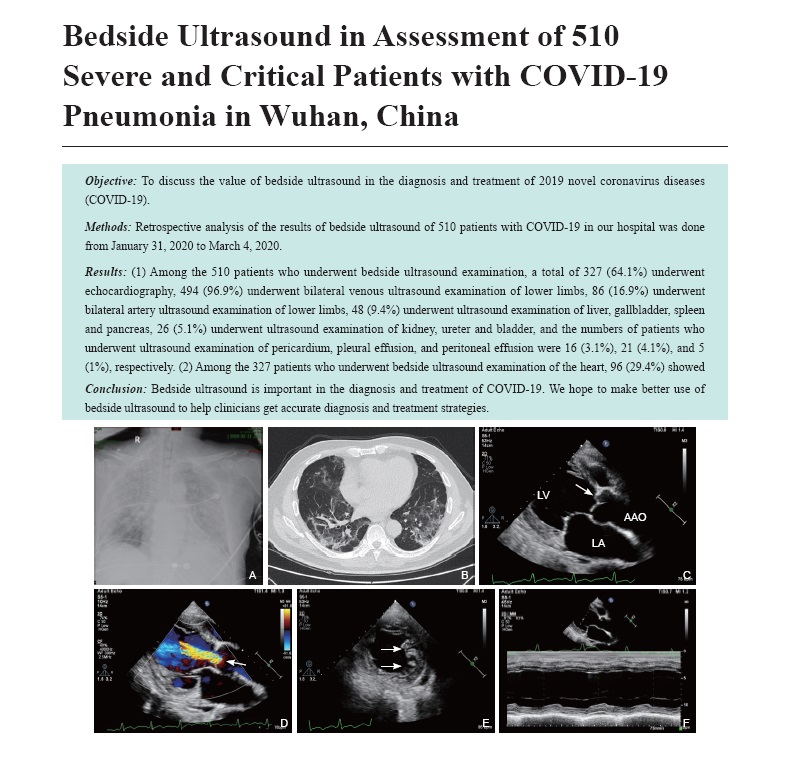

ADVANCED ULTRASOUND IN DIAGNOSIS AND THERAPY >
Bedside Ultrasound in Assessment of 510 Severe and Critical Patients with COVID-19 Pneumonia in Wuhan, China
Received date: 2020-03-30
Online published: 2020-04-17
Objective: To discuss the value of bedside ultrasound in the diagnosis and treatment of 2019 novel coronavirus diseases (COVID-19).
Methods: Retrospective analysis of the results of bedside ultrasound of 510 patients with COVID-19 in our hospital was done from January 31, 2020 to March 4, 2020.
Results: (1) Among the 510 patients who underwent bedside ultrasound examination, a total of 327 (64.1%) underwent echocardiography, 494 (96.9%) underwent bilateral venous ultrasound examination of lower limbs, 86 (16.9%) underwent bilateral artery ultrasound examination of lower limbs, 48 (9.4%) underwent ultrasound examination of liver, gallbladder, spleen and pancreas, 26 (5.1%) underwent ultrasound examination of kidney, ureter and bladder, and the numbers of patients who underwent ultrasound examination of pericardium, pleural effusion, and peritoneal effusion were 16 (3.1%), 21 (4.1%), and 5 (1%), respectively. (2) Among the 327 patients who underwent bedside ultrasound examination of the heart, 96 (29.4%) showed results of positive for other abnormalities or complications, in which 31 (9.5%) had abnormal left ventricular wall motion, 42 (12.8%) were with valvular heart disease, 3 (0.9%) showed coronary heart disease, 19 (5.8%) showed the enlargement of right heart with pulmonary hypertension (PAH), and 1 (0.3%) had congenital heart disease. In addition, 6 of the 327 echocardiography patients showed negative results (no other abnormalities or complications), accounting for 1.8%. (3) Among the 494 patients who underwent bilateral venous examination of lower limbs, 182 (36.8%) had phlebothrombosis. Eighty-six (86) patients underwent bilateral artery examination of lower limbs, and 63 (73%) of them had positive results, in which 5 patients showed arterial occlusion and the other 57 patients showed atherosclerosis. (4) Thirty-three (33) patients underwent ultrasound examination of liver, gallbladder, spleen, and pancreas, and 23 (70%) of them showed positive results. Among the 26 patients who underwent the urological examination, 7 (26.9%) showed positive results. Additionally, there are 2 positive findings in 21 patients who underwent the examination of pleural effusion (9.5%), and 1 positive case in 5 patients who underwent the examination of abdominal effusion (20%).
Conclusion: Bedside ultrasound is important in the diagnosis and treatment of COVID-19. We hope to make better use of bedside ultrasound to help clinicians get accurate diagnosis and treatment strategies.

Key words: Corona virus disease 2019; Bedside ultrasound; Severe; Critical
Wang, MD Bin , Zhang, MD Li , Zhang, MD Danqing , Yuan, MD Hongliang , Wu, MD Chun , Zhang, MD Yongxing , He, MD Lin , Wang, MD Rui , Wang, MD Jing , Xie, MD, PhD Mingxing . Bedside Ultrasound in Assessment of 510 Severe and Critical Patients with COVID-19 Pneumonia in Wuhan, China[J]. ADVANCED ULTRASOUND IN DIAGNOSIS AND THERAPY, 2020 , 4(2) : 60 -66 . DOI: 10.37015/AUDT.2020.200018
| [1] | National Health Commission. Beijing, March 5, 2020.[In Chinese]. |
| [2] | Diagnosis and Treatment Protocol for Novel Coronavirus Pneumonia (Trial Version 7), National Health Commission & State Administration of Traditional Chinese Medicine. (2020-03-04) [In Chinese]. |
| [3] | Guan WJ, Ni ZY, Hu Y, Liang WH, Ou CQ, He JX, et al. China Medical Treatment Expert Group for Covid-19. Clinical Characteristics of Coronavirus Disease 2019 in China. N Engl J Med 2020. DOI: 10.1056/NEJMoa2002032. |
| [4] | Huang C, Wang Y, Li X, Ren L, Zhao J, Hu Y, et al. Clinical features of patients infected with 2019 novel coronavirus in Wuhan, China. Lancet 2020; 395:497-506. |
| [5] | Echocardiography Group, Chinese Medical Association, Cardiovascular Disease Imaging Group of Cardiovascular Branch of Chinese Medical Association. Bedside echocardiographic protocol for Novel Coronavirus Pneumonia (NCP) and remote consultation. [2020-02-14] |
| [6] | Jin W, Wang Z, Zhu T. Evaluation of pulmonary hypertension with echocardiography. Chinese Journal of General Practitioners . 2019; 18:1196-1198.[In Chinese]. |
| [7] | Galiè N, Humbert M, Vachiery JL, Gibbs S, Lang I, Torbicki A, et al. ESC Scientific Document Group. 2015 ESC/ERS Guidelines for the diagnosis and treatment of pulmonary hypertension: The Joint Task Force for the Diagnosis and Treatment of Pulmonary Hypertension of the European Society of Cardiology (ESC) and the European Respiratory Society (ERS): Endorsed by: Association for European Paediatric and Congenital Cardiology (AEPC), International Society for Heart and Lung Transplantation (ISHLT). . Eur Heart J 2016; 37:67-119. |
| [8] | Nagueh SF, Smiseth OA, Appleton CP, Byrd BF 3rd, Dokainish H, Edvardsen T, et al. Recommendations for the Evaluation of Left Ventricular Diastolic Function by Echocardiography: An Update from the American Society of Echocardiography and the European Association of Cardiovascular Imaging. J Am Soc Echocardiogr 2016; 29:277-314. |
| [9] | Wang SS, Zhou X, Lin XG, Liu YY, Wu JL, Sharifu LM, et al. Experience of clinical management for pregnant women and newborns with novel coronavirus pneumonia in Tongji Hospital, China. Curr Med Sci. 2020 Mar 26. DOI: 10.1007/s11596-020-2174-4. |
| [10] | Chen N, Zhou M, Dong X, Qu J, Gong F, Han Y, et al. Epidemiological and clinical characteristics of 99 cases of 2019 novel coronavirus pneumonia in Wuhan, China: a descriptive study. Lancet 2020; 395:507-513. |
| [11] | Wang D, Hu B, Hu C, Zhu F, Liu X, Zhang J, et al. Clinical Characteristics of 138 Hospitalized Patients With 2019 Novel Coronavirus-Infected Pneumonia in Wuhan, Chinaa. JAMA 2020:e201585. |
/
| 〈 |
|
〉 |